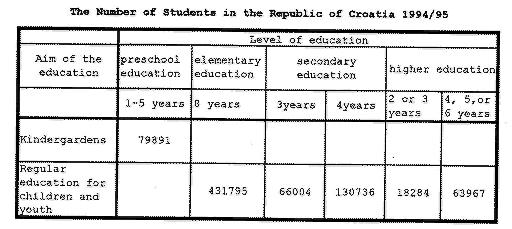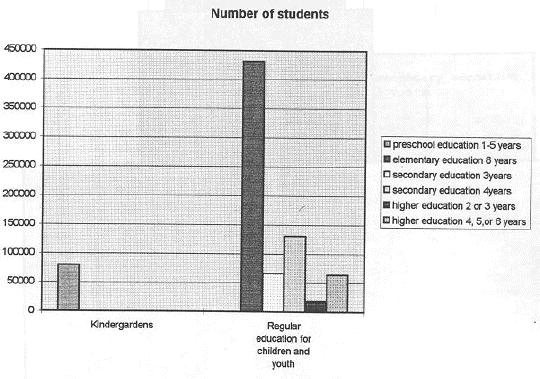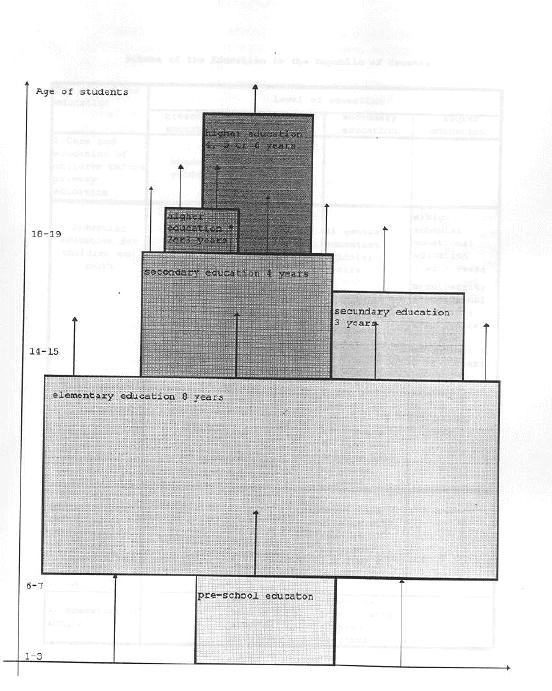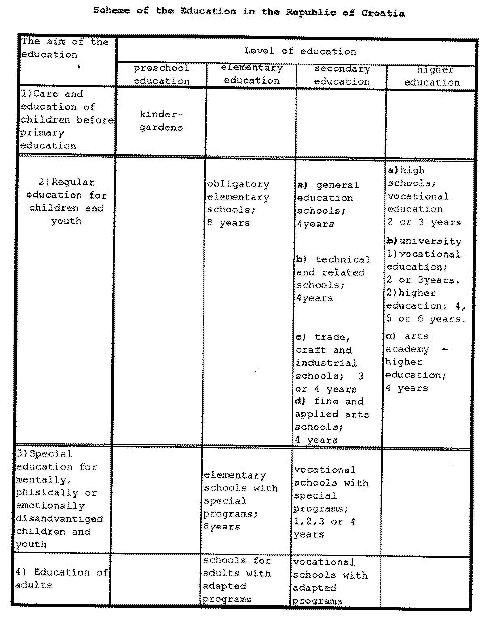



Present day school system in Croatia is a reflection of economic
potentials and political features of the Croatian people in current and
former political situation.
Until 1918, in the period when Croatia was a part of Austro-Hungarian Monarchy, the Croatian school system resembled the Austrian and Hungarian ones. From 1919 to 1945 it was adjusted to the needs of the new born union of South Slavs within the kingdom of Yugoslavia, and during the World War II it had to adapt again to the new circumstances. Atter 1945 it was reorganized to meet the needs of the new born communist Yugoslavia.
The multi-parly elections held in 1990 brought major changes to the social and political life in the Republic of Croatia. Atter the break of Yugoslavia Croatia subsequently became an independent and democratic state with multy-party system, parliamentary democracy, co-ownership and tendencies to adopt European values and join the European cultural climate. The winning and the establishment of democracy required changes in former educational system. These changes began in 1990, intensified in 1991 and are still under way.
The first improvements were defined as short-term changes with the following tasks:
The school and educational content have been freed - of ideology. Marxist ideology and the corresponding interpretation of educational content have been abandoned on a general philosophic-ideological plan, together with the ideologized cliches which used to create deformed concepts of the past and present.
The youth is consequently being educated to adopt the ideas of democracy, human rights and multiculturalism.
Basic changes of the provisions of the pre-school, primary and secondary education law paved way for a new orientation, democratic changes and improvements of individual segments of the educational system.
The existing educational system is still changing and comprises the following stages:
1. Pre-school education
This system covers about 32% of the total number of children aged 1-6 (approximately 110000).
Pre-school education is an integral parl of the educational system and includes children up to the end of their sixth year, at which age they enroll in primary schools. Pre-school education is also required by the Law of Social Care for Children of Pre-school Age whereas a new law is expected to be passed, providing for an integral approach to the educational, medical and social dimension in the field of pre-school education.
The prevailing programme form is the kindergarten, in most cases combined with an infant nursery.
Children aged 5 and 6, according to their parents' wish, attend so called "little school", a sort of preparation class for the first grade. This subgroup includes approximately 15% of 5 and 6-year olds (8500), mostly those children who didn't attend the nursery and kinderganens.
The Law on Social Care for Children of Pre-school Age and the new conceptional orientation stimulates the following:
The new program orientation in the field of pre-school education is based on the principles of humanism, on the awareness of specific characteristics and regularities in the development of pre-school children, on the understanding of human development in general and on the consideration of the education that pre-school children gain outside their families.
This concept basically starls from the Convention on the Rights of the Child.
Pre-school education is being carried out in 814 public, 24 church and 18 private institutions.
2. Compulsory primary education
In the Republic of Croatia primary education lasts for eight years. It is performed in a uniform primary school that is compulsory for all children between 6 and 14 years of age.
The eight year primary school resulted from the combining of the former four-year primary school with the selective four year secondary school into a uniform, compulsory primary school, which still has a system of class-teaching, with class-teachers from 1st to 4th form and a system of subject-teaching and subject-teachers from 5th to 8th form.
Primary school is the basis of the entire school system in Croatia and the fundament for the continuation of education on secondary level, as well as for the choice of vocational education. Primary school is the only compulsory school of general education in Croatia. The question of compulsion is regulated by the Constitution and the Primary Education Law. They oblige parents as well as society as a whole to assure that children enroll in schools and that adequate conditions are provided for a solid education.
In the school year 1993/94.The new Curricula Framework for Primary Schools in the Republic of Croatia was created. It comprises new programmes accepted during the previously organized public competition, programmes corrected according to the requirements laid down by the evaluation commissions, and existing programmes that need no major corrections.
There are two organizational models of primary school: the half-day and the whole-day model (extended stay, whole day stay and whole-day school). Every model has its peculiarities in regard to the structure and number of pupils, the organization of educational work, the time table, the assignment of teachers, and other elements.
The traditional class, subject and lesson make the axis of the life and work at school. Besides the class, an increasingly frequent form of education is work in smaller groups, specially in some subjects and extra-curricular activities.
In 1992/93 school year, Croatia had 1930 primary schools with 446621 pupils. The majority of them (98%) successfully finished their primary school and 94% of them continue their education in secondary school.
3. Secondary education
Secondary education has experienced the most extensive changes, which represent a transition to a new educational system.
Because of the existing eight-year primary education whose curricular organization and duration determined the features, scope and intensity of the curricula on secondary school level, it was impossible to perform a thorough reorganization and to establish a system similar to those in other European countries. Secondary education is a connotation of primary school and it is characterized by several types of schools (grammar schools, vocational, and art schools) and the maximum duration of four years.
3.1. Grammar schools
Grammar schools are institutions that offer general education and last for four years. As a secondary school, the grammar school is a transitory level towards professional education in institutions of higher education.
Grammar schools are divided into general, linguistic, classical and scientific.
There are no major differences in the curricular structure of the different types of grammar school. The general grammar school is keeping in balance scientific, mathematical and linguistic contents, whereas the timetables of linguistic and scientific grammar schools contain more lessons of linguistic and scientific subjects respectively.
The enrollment at grammar schools is regulated by a classification procedure, which takes into account the pupil's overall results in the 7th and 8th grades of primary school and his specific results in five subjects of importance for the continuation of education in certain type of grammar school. Most grammar schools use a classification system based on points. Afler the completion of secondary education, pupils take a school-leaving exam, which enables them to matriculate at the university.
In 1992/93 Croatia had 123 grammar schools.
3.2. Art education
An schools educate pupils in the flelds of music, dance, fine art and design. They last for four years.
Generally, pupils enter secondary ballet or rhythmic and dance schools after graduating from primary music and dance schools. Gifted pupils who did not graduate from such schools are allowed to enter preparatory classes of some artistic programmes, providing that they meet the requirements of the an school in question.
Common contents of music and dance programmes are identical to those in the general grammar school curriculum, except that the pupils are not obliged to attend natural science classes. The reminding part of the curriculum consists of theoretical and practical professional training.
In school year 1992/93 1622 students, (or 0.8%) attended 16 music schools and 121 students attended 2 ballet schools in Croatia.
3.3. Vocational education
Vocational schools are divided into technical, medical, economic, commerce, agricultural and similar schools that last for four years and into industrial and craft schools that offer training for the same professions but last three years.
The vocational education system also comprises training for simpler professions and last from one to three years.
a. Technical and related schools
A characteristic of technical schools is that they offer solid general and vocationally relevant education and training.
Curricula of technical and related schools are organized as follows:
In most vocations two types of qualification are sufficient. Four-year schools that are not technically oriented but have curricula connected with medicine, the catering and tourism trade, administration, economics and the like mostly offer only one qualification. Education in technical and related schools is completed with a school-leaving exam.
Four-year educational programmes for technicians and other vocations are conducted in 167 schools. In 163 schools classes are given in Croatian and in 4 schools in the languages of minorities.
Education in industrial schools can be organized according to the so-called dual system, where vocational and general education are separated. The general education programme is conducted in schools and the vocational part in educational workshops established in factories or firms.
b. Craft schools
Due to their tradition and the tradition of the crafts in Croatia, trade schools might soon adopt the dual training system.
It is characteristic of this type of education that theory classes are given at school whereas the practical training takes place mostly at the tradesmen's workshops (with whom pupil has signed a contract on apprenticeship) and only a smaller part of it at school workshops.
c. Industrial and related schools
Industrial and related schools educate pupils in the fields of medical care, administration, catering and tourism trade, etc. in order to allow them a quick start in their profession, without a long preparatory period. The curricula of these schools include minimal general education contents, common vocational contents and optional contents.
Since the education for less demanding vocations is primarily aimed at obtaining practical knowledge and skills, more than 60% of the lessons is dedicated to practical training.
d. Special secondary schools
Besides the previously presented schools, the educational system in Croatia also comprises special schools of various types.
The grammar school system includes:
The schools run by the Ministry of the Interior and the Ministry of Defense have a special status in the system of secondary vocational schools. These schools are not under direct jurisdiction of the educational administration.
Education at grammar schools, art and four-year vocational schools ends with a school-leaving exam and university entrance qualification. Graduates from three year vocational schools don't have the possibility to enter universities, though they can enroll at technical higher schools and subsequently continue their education at higher level.
4. Higher education
Higher education in Croatia is conducted at faculties, academies and schools of higher education. They all compose the universities of Zagreb, Split, Osijek and Rijeka. The University of Zagreb consists of 29 faculties, three art academies, one institute and one higher school.
The University of Split has 9 faculties, the University of Rijeka 10 and the University of Osijek 8 faculties.
Compared to the secondary-school system, higher education did not experience major changes during the past period. The Law on Institutions of Higher Education was passed in October 1993.
The Law defines the following types of institutions of higher education: university, college, faculty, art academy, school of higher education. A faculty and art academy are institutions of higher education within a university whereas a school of higher education can be a part of university or an autonomous institution.
There are three levels of higher education in Croatia:
In 1993/94. Croatia had 80410 students. Higher education lasts from two to six years.
5. Education of disabled children and youth
The social and expert approach starts out from the fact that upbringing, education, and rehabilitation of disabled children are integral parts of the educational system.
Children and young people with minor handicap are educated and rehabilitated under regular conditions in a way that enables their full or partial integration. Those with a major handicap attend special institutions (up to 21 years of age).
Full integration is achieved by putting handicapped pupils into regular classes where they take part in the standard or an adapted teaching programme. This process involves individual tuition and expert help from a special teacher.
Disabled pupils who can neither attend school nor work at home or in medical institution receive expert help from special school teachers.
Pupils with severe handicap are educated and trained in special educational, medical or social-care institutions.
6. Adult education
Adult education in Croatia comprises formal (primary and secondary) and informal schooling. Depending on the type of implementation programme and school facilities, adult education is performed in regular classes, in the form of consultations and instructions or through correspondence schools.
There are about 260 different institutions in Croatia providing adult education.
7. Education of members of ethnic communities and minorities
Education in the languages of ethnic and national communities or minorities is a part of the uniform educational system coordinated by the Ministry of Education and Sport. The Law on Education in the Languages of Minorities and Amendments on several laws in the field of education regulate relevant issues in that field. Primary-school curricula were designed for the members of Italian, Hungarian, Czech, Slovak, Ruthanian and Ukrainian ethnic and national communities or minorities, whereas secondary-school curricula were designed for the Italian, Czech and Hungarian communities.
Drafl Programme of Education for Members of the Serbian Nationality is already prepared by the Ministry of Education and Sport and is offered to the Serbian Cultural Society "Prosvjeta". In the moment the representatives of both sides are discussing the concept of Programme.
The Ministry for Education and Sport has also prepared programs of religious instruction in primary and secondary schools.
8. Teachers training
University education of teachers is conducted on four universities, 10 pedagogical faculties and at the Catholic Theological Faculty.
The permanent training of teachers is realized after their employment. Novice teachers are obliged to take a qualification exam afler a preparatory period. Afler that, it is their duty to take care of their permanent improvement in the fields of education, psychology and methodics.
The in-service training of teachers comprises contents in their special fields as well as in the fields of pedagogy, psychology, and methodics. Courses are organized by the Ministry of Education and Sport, pedagogical and other faculties, specialized centres and secondary schools.
9. Education of the Croats in Diaspora
Besides the previously presented schools, the educational system in Croatia also comprises schools for children of our citizens living and working in foreign countries.
Following the main directions of transcontinental European migrations in the second half of the nineteenth century, many Croats migrated to North and Latin America, Australia, New Zealand, and South Africa. Emigration from Croatia continued after World War I, but somewhat less intensively. As a direct conseauence of World War II tens of thousands emigrated from Croatia immediately afler the war had ended. At the beginning of 1960's many migrated because of economical reasons. The exact number of emigrants is impossible to establish because of the lack of statistic data, both in Croatia and in their immigrant countries, but it is supposed to be two million of them.
For the children of emigrants, Croatia has organized so called "Croatian school", as additional education to regular school in immigrant countries.
There are two organizational models of "Croatian school"; integral and consular type.
Integral type of education integrates Croatian language in regular education system of the foreign country. Ministry of Education of immigrant country is financing this programme, takes care of curricula, teachers, textbooks, ect.
Consular type of education means that Ministry of Education and Sport of the Republic of Craotia controls, sends teachers from Croatia and finances this schools.
Curriculum for both types of "Croatian school" is based on the Croatian language and literature with elements of national culture and tradition, Croatian geography and national history. This education is designed for primary and secondary level. Pupils have four lessons per week.
There are about 15000 pupils in "Croatian schools" all over the world.
According to the Government Office for the Victims of War register, during the aggression on Croatia 263 children were killed, 1004 were wounded, 514 were declared missing. There are 47,795 displaced children, and 58,638 refugees children from B&H.
The school buildings sustained heavy damages during the war. The number of preschool institutions destroyed or damaged is 128, 347 primary schools and 88 secondary schools.
In primary schools there are 21,717 displaced and 29,319 refugee pupils. About 90% of refugee and displaced children are included in normal schooling. The other 10% (about 3,000 pupils) are enrolled in special refugee schools. Refugee and displaced children now represent 7.1% of all pre-school children; 10.6% of primary school children; and 8.04% of secondary school children in Croatia. In all schools, there is now a total of 74,636 pupils over and above the number of which the school system was conceived, or a total about 10% additional pupils. Certainly this has caused a serious strain on the educatlonal infrastructure.
Classes are much larger now than in the past, as funding is not available to hire additional teachers or expand buildings. In primary schools, the number of pupils in class has increased from 30 to 36. There is not enough room, all eauipment is in short supply. An increased number of pupils per class has not only put a strain on the existing teaching load and the resources, but has caused a shortage of teachers by 13.03%. An increased number of pupils per class has further put a strain on students with special educational needs as they are integrated in ordinary classes. Handicapped children are even more affected.



